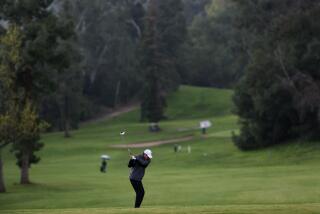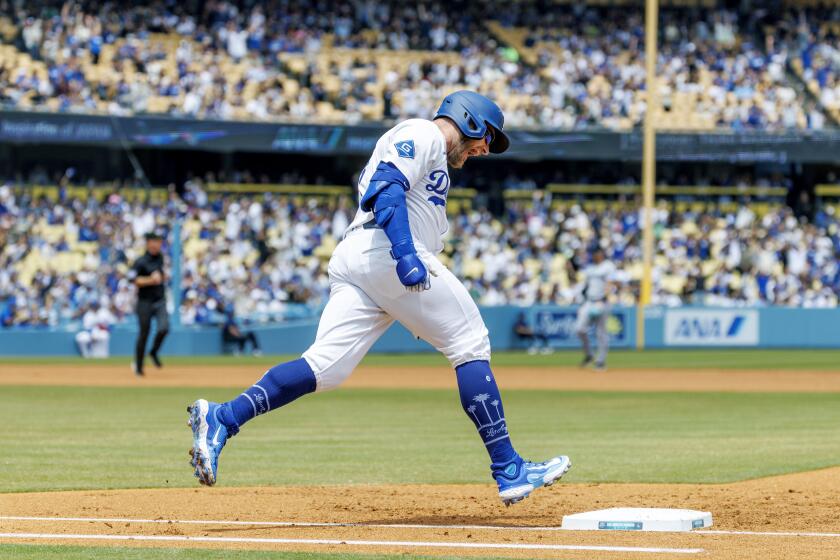Golfers Getting Some High-Tech Help From Computer Graphics : Instruction: Pelican Hill system lets students see their swing, and compare it to the optimum.
- Share via
NEWPORT COAST — Every golfer who has needed a bogey on the 18th hole to break 90 and proceeded to hit his tee shot out of bounds and his approach into the water, knows golf is all about consistency.
Every golfer has hit a great shot; very few hit them almost every time. Since most golfers don’t have the time or inclination to hit a hundred balls a day at the range, maybe that computer-like swing the pros repeat for 72 holes every week is out of the question.
A computer-assisted swing, however, isn’t.
Wouldn’t it be nice to have a clue what you’re doing wrong? Or, maybe more important, a clear idea of everything you’re doing right?
Pelican Hill Golf School’s ASTAR golf learning system, a technology that combines video and computer graphics, can provide both. It’s a high-tech teaching aid that allows students to see what is right and wrong with their swing and effectively work to change it.
“It’s a really nice way to teach,” said Glenn Deck, Pelican Hill’s head teaching pro. “The video seems to drive home things for students and the whole system speeds up the process of learning the correct swing.
“Right or wrong, what you’ve done in the past feels comfortable and even a little change feels drastic and awkward. That’s where the video really comes in, proving to the student that what feels like a drastic change may not even be enough.”
The ASTAR system includes a video camera and a hooded monitor with a VCR and computer controlled by a touch-pad that works like a mouse. It is set up on the driving range, allowing the integration of instruction and practice and the bonus of instant feedback. Slow-motion video helps the student visualize swing mechanics. The instructor makes comments and can superimpose any number of different colored lines and circles to illustrate his critique, using both face view and back angles.
It’s a lot like having Johnny Miller diagram your swing on the telestrater . . . except maybe the flaws aren’t so subtle.
“Notice how you unhinge the club too early and fail to keep your head still and the lack of turn and your hands are too quick . . . “
For many students, seeing is understanding and that seems to be a key to rapid improvement.
“I’m one of those people who needs to see it to get it,” said Cathy Enderwood-Singh of Irvine, “and this lets you see exactly what you’re doing. It’s a great visual aid.
“I’ve been taking once-a-week lessons with Glenn using it since January, and I can really see the improvement. My scores are coming down every week.”
In addition to the bio-mechanic analysis, ASTAR offers a library of men and women professionals so Joe or Josephine Student can compare their swings on a split screen with Jack Nicklaus or Jan Stephenson--or a host of other pros--in slow motion or time lapse.
“For the better players, being able to pull up a tour pro and see what they’re doing really helps in making the more subtle changes,” Deck said.
The system has a number of features, some of which might seem gimmicky to one student while proving a key to improvement for another.
A stick-man with a bio-mechanically perfect swing can be super-imposed on top of the student’s video. The swing can be clicked forward a single frame at a time or in slow motion. The body’s position at address can be immediately compared with the position at impact. The path of the hands compared to a perfect circle. The exact degree of angle of the club at the top of the swing and halfway down.
The instructor can also pull up any frame and make a printout so the student has a hard-copy picture of a key point in his swing.
“I’d say that ASTAR really helps at least 90% of the people who take a lesson,” Deck said. “Some people are totally feel players and it might not help them as much. Most people learn by a combination of visual input and feel. The purely visual people are the ones who benefit the most. But one of the keys for everyone is to see their swing evolving and changing, to actually see the improvement.
“And the camera doesn’t lie. I’ll talk to a student about posture, for instance, and make some changes and then he’ll say, ‘Well, my hips are really sticking way out now.’ And I’ll say, ‘Are they? Let’s see.’ And then he’ll see that they’re not sticking way out at all.”
Another advantage of the system is efficiency. The student can make a video copy of the entire lesson--which at Pelican Hill will cost between $45 and $75 for 45 minutes, depending on the teaching pro--and then rent the system and a bucket of balls for $20 for 30 minutes by himself.
Watch your lesson at home on your VCR, remind yourself of exactly what you want to work on, then go to the range and add your practice swings to the tape. You not only document your progress, but you can check the replay between each swing and continue to correct flaws you now know how to detect.
Give yourself a lesson. The system, which has only four buttons for student use, is about as difficult to master as an ATM.
“It’s so easy to forget what you learn in a golf lesson, but when you have the tape you can watch it any time,” Enderwood-Singh said. “I watch mine at least twice a week. It just reinforces everything. It’s like a mental lesson.”
Deck likes another aspect of the program.
“It reaffirms that your work is paying off and it makes students want to practice more.”
And, he hopes, take more lessons.
One recent student, who had never had a lesson, spent half an hour with Deck and the ASTAR recently and learned--much to his surprise--that there were many good things about his swing.
“You always want to point out all the good things,” Deck said. “This system can confirm a lot of good things. The golf swing is kind of like an assembly line and we always like to look at things in order of how they happen.”
Deck liked this student’s posture and aim, but suggested a slight grip change. He clicked through the student’s swing a frame at a time, pointing out more positives: good balance, nice turn, decent follow-through. He said most of this student’s problems stemmed from the position of his elbows at the top of the backswing--too far apart with the right elbow pointed out instead of down.
Deck, who has been a teaching pro for 12 years at Hilton Head Island, La Quinta Hotel and Golf Club and other courses, didn’t need a video camera or a computer to pick out this flaw.
But the ASTAR clearly aided the communication process, helping the student understand what needed to change, allowing him to first see it and then feel it.
Don’t expect miracles, though. It’s like anything else. There’s no substitute for practice.
“The instructor can give you drills to help correct your swing,” Deck said, “but he can’t do them for you.”
(BEGIN TEXT OF INFOBOX / INFOGRAPHIC)
High-Tech Golf Lessons
Pelican Hill Golf School uses a computerized video program so students can view their swings and compare them to those of top professionals. Using computer graphics, golfers see proper posture, hand and arm positions and other key factors superimposed over their swings. The video allows students to see exactly what they are doing wrong and view their progress as they attempt to make corrections.
1. The angle of the arms and club at the beginning of the downswing should be 90 degrees or less.
2. The hands should stay on line with the circle throughout the swing.
3. On the downswing, the club should be even with or inside its path on the backswing.
Researched by JOHN WEYLER / Los Angeles Times
More to Read
Go beyond the scoreboard
Get the latest on L.A.'s teams in the daily Sports Report newsletter.
You may occasionally receive promotional content from the Los Angeles Times.









